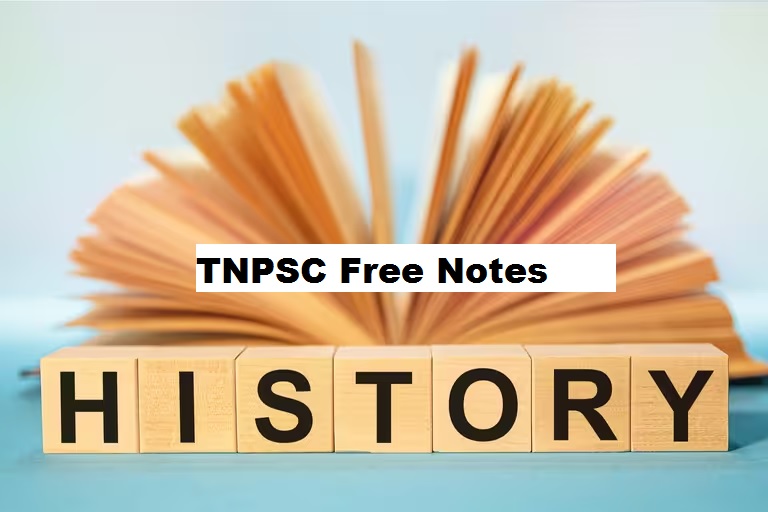இந்தக் கட்டுரையில், TNPSC குரூப் 1, குரூப் 2, குரூப் 2A, குரூப் 4 மாநிலப் போட்டித் தேர்வுகளான TNUSRB, TRB, TET, TNEB போன்றவற்றுக்கான முறைகள் இலவசக் குறிப்புகளைப் பெறுவீர்கள்.தேர்வுக்கு தயாராவோர் இங்குள்ள பாடக்குறிப்புகளை படித்து பயன்பெற வாழ்த்துகிறோம்.
Industry Mining and Metallurgy
Mining and metallurgy was one of the most flourishing industries during the Gupta
period.
Amarasimha, Varahamihira and Kalidasa make frequent mention of the existence of
mines.
The rich deposits of iron ore from Bihar and copper from Rajasthan were mined
extensively during this period.
The list of metals used apart from iron were gold, copper, tin, lead, brass, bronze, bell-
metal, mica, manganese, antimony, red chalk (sanssilajata) and red arsenic.
Blacksmiths were next only to agriculturists in importance in the society.
Metal was used for the manufacture of various domestic implements, utensils and
weapons.
The improvement in the ploughshare, with the discovery of iron, for deep ploughing and
for increasing cultivation happened during this period.
The most important and visible evidence of the high stage of development in metallurgy
is the Mehrauli Iron Pillar of Chandragupta II in the Qutb Minar Complex in Delhi,
identified with Chandragupta II. This monolith iron pillar has lasted through the
centuries without rusting.
It is a monument to the great craftsmanship of the iron workers during the Gupta
period.
Coin casting, metal engraving, pottery making, terracotta work and wood carving were
other specialised crafts.
A significant development of the period in metal technology was the making of the seals
and statutes of Buddha and other gods.
It was laid down that the people had to pay for the wastage in the process of smelting of
iron, gold, silver, copper, tin and lead.
Trade and Commerce
The contribution of traders to the soundness of the Gupta economy is quite impressive.
Two distinctive types of traders called sresti and sarthavaha existed.
Sresti was usually settled at a particular place and enjoyed an eminent position by virtue
of his wealth and influence in the commercial life and administration of the place.
The sarthavahawas a caravan trader who carried his goods to different places for
profitable sale.
Trade items ranged from products for daily use to valuable and luxury goods. They
included pepper, sandalwood, ivory, elephants, horses, gold, copper, iron and mica.
The abundant inscriptions and seals mentioning artisans, merchants and guilds are
indicative of the thriving crafts and trade. (Guild is a society or other organisation of
people with common interests or an association of merchants.)
They remained virtually autonomous in their internal organisation, and the government
respected their laws.
These laws were generally drafted by a larger body, the corporation of guilds, of which
each guild was a member.
The Narada and Brihaspati Smritis describe the organisation and activities of guilds.
They mention that the guild had a chief and two, three or five executive officers.
Guild laws were apparently laid down in written documents. The Brihaspati Smriti refers
to guilds rendering justice to their members and suggests that these decisions should,
by and large, be approved by the king.
There is also mention of the philanthropic activities of guilds, for instance, providing
shelter for travellers and building assembly houses, temples and gardens.
The inscription also records that the chief of the guilds played an important role in the
district-level administrative bodies.
There is also mention of joint corporate bodies of merchant-bankers, caravan merchants
and artisans. The names of donors are mentioned in this inscription.
Usury (the lending of money at an exorbitant rate of interest) was in practice during the
Gupta period. The detailed discussion in the sources of that period indicates that money
was used, borrowed and loaned for profit.
There were many ports that facilitated trade in the western coast of India such as
Calliena (Kalyan), Chaul port and the markets of Mabar (Malabar), Mangarouth
(Mangalore), Salopatana, Nalopatana and Pandopatana on the Malabar coast.
Fahien refers to Tamralipti in Bengal as an important centre of trade on the eastern
coast. These ports and towns were connected with those of Persia, Arabia and
Byzantium on the one hand and Sri Lanka, China and Southeast Asia on the other.
Fahien describes the perils of the sea route between India and China. The goods traded
from India were rare gems, pearls, fine textiles and aromatics. Indians imported silk and
other articles from China.
The Guptas issued many gold coins but comparatively few silver and copper coins.
However, the post-Gupta period saw a decline in the circulation of gold coins.
**************************************************************************
| Adda247 TamilNadu Home page | Click here |
| Official Website=Adda247 | Click here |




